BrandMania CHINA
During my November visit to China I saw all the signs of what I took to be runaway “BrandMania”, though according to Dan Harris in a recent China Law Blog “China’s Stunning Lack of Brands” , one might think the complete opposite.
My view of this “brand” thing is perhaps somewhat different. I noticed brands everywhere; brands I know well, the obvious Euro ones like Fendi, LV, Audi, and others I am less familiar with, but ‘brands’ never the less.
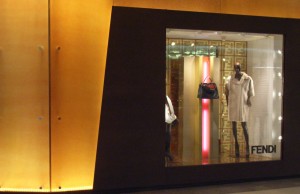
Fendi at Plaza 66 in Shanghai
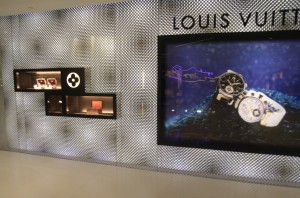
LV at Pacific Place in HK
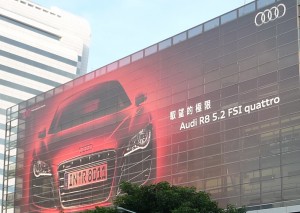
Near 101 in Taipei
But what really stood out to my eye were the ‘knock off brands’ – the obvious imitations, like the almost identical logo of the round green and black steaming coffee cup which we saw all over …….slightly modified but totally recognizable, and the two obvious knock-offs (images below), that we came across in a department store commingling with the real things like Nautica and Aquascutum (or at least what appeared to be the real things) ☺
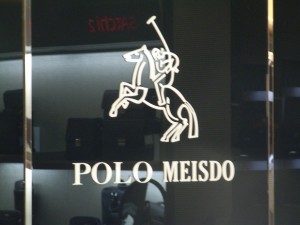
How about this, Ralph?
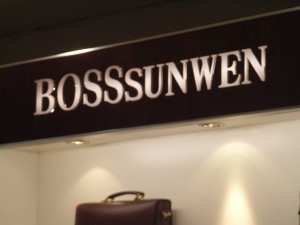
Who’s the Boss, Hugo?
SBUX is everywhere, and in Hangzhou where there were Starbucks and the UK brand Costa (way better coffee IMHO), always busy, though expensive by our standards (a mocha latte cost noticeably more than in Vancouver). The typical Hangzhou clientele would be perfectly at home in Seattle and Vancouver coffee haunts and visa versa . Has coffee drinking taken over China, the home of tea? “O, no we don’t really like coffee, we always order flavored milk or chocolate drinks and not coffee, it’s the coffee culture we are in love with “ was the response or similar I received to my inquiry about China’s new love affair with corporate coffee.
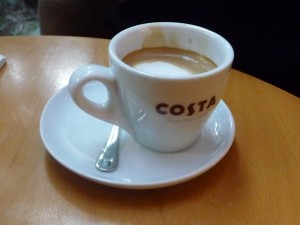
Costa offset!

James, equally at home in Hangzhou.

Hanging out in Hangzhou.
The sheer quantity of ‘luxury’ European and American brand locations in just the 4 cities I visited, was mind blowing! Are these retailers profitable? And do they need so many locations to gain credibility and acceptance? Ferrari have few locations for their retail boutiques, one of which I photographed in Macau last April; but judging by the amount of Ferrari-logo apparel this is a chosen and very recognized brand (real or knock off) for many of the “Chuppie” guys we saw sporting the Ferrari logo on clothing and/or accessories.
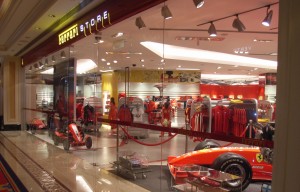
Ferarri at the Wynn Macau
I always thought (having come originally from the UK) that the US was awash in advertising, and quite invasive at that! However, this struck me as much more so in China, and even more intense than on my previous visits (2006 & Spring 2009). This time what caught my attention the most was the cool little 6” X 9” screens on almost every coffee shop and small restaurant table, broadcasting mini-video adverts; same types of screens on the back seats in all the taxis (difficult to impossible to shut off!). The elevators with non-stop video ads I had seen on previous trips, courtesy of Focus Media.
A few rides on the Shanghai subway was an illustration of how every square inch can be used for advertising, even on the ‘standee-straps’ overhead……each one ‘sponsored’ by an advertiser!
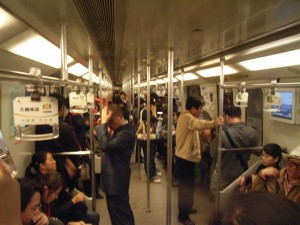
Shanghai subway just before rush hour!
One evening in Hangzhou I had the opportunity to take a group of new friends out for dinner. The group consisted of two students Yao & Lily (graduating soon), Bill an engineer in an environmental company, and the personal assistant/driver for a prestigious businessman in Hangzhou whom we named Shaun. All had assisted me during my two most recent visits to China, so I wanted to accommodate their choice for dining out. Pizza Hut was their hands down choice!! Well, OK, so PH has morphed into more than a take-out place in Asia, sort of more “Italian restaurant” chain like California Pizza Kitchen. The space was huge (compared to the Pizza Hut I am familiar with) and our group obviously was extremely pleased with their choice. The menu had both the typical US style fast food Italian and an interesting thin crust sausage topping pizza that tasted exactly like a Chinese stir fry. Actually it was not bad.
So, since I just visited tier-one cities, was I getting a distorted view of BrandMania? Was I ascribing the attributes of these mega cities to the whole of China, something which is not uncommon for the inexperienced like myself to do? ☺ In addition to flying, I traveled the hour & twenty minutes between Shanghai and Hangzhou by high speed train; could this be the balanced view I needed? No comment!

Is this a branding opportunity waiting to happen?

Dan Harris’s observation is somewhat surprising, considering everything I observed in the cities: I would have assumed the Chinese companies would be eager to snap up US and European big brands (and not only big). Yet in a subsequent China Law Blog Dan mentions an interesting new twist; companies from the west manufacturing in China for the Chinese consumer ~ makes me think that POLO MEISDO and BOSSsunwen are examples of this☺ Does anyone know if these are in fact created by Ralph Lauren and Hugo Boss for the China market, or are they just more clever copycats?
What message does this “BrandMania” send? Consumerism is IN, and HERE to stay? China’s “stimulus program” is stimulating frenzied consumption? Chinese brand advertising has been successful? AND why has the ultimate brand, the “real” iPhone failed so far in China?
Please comment below or email me at casudi@esse-group.com and check out my recent China travelog~ all about Design, People & Food.








December 17th, 2009 at 12:22 am
China has few worldwide recognizable brands of its own: Qingdao Beer, Haier… I live in China and those are the only two I can come up with off the top of my head. There is Geely. But of what is it a symbol?
Even when Brandmania was not as visually present as it is now, it still existed in the minds of the Chinese. While centered in the urban centers, evidence of it could be found in the hinterland. In general what is Western has been considered better, hipper, sexier. Almost 5 years ago while traveling deep into Western China I photographed an advertisement outside a pharmacy. The ad used a photo of John Majors to sell Viagra.
Due to an intersection of Brandmania with the most unequal wealth distribution in Asia, and one of the most unequal in the world, I am privy in this Tier 2 (Qingdao) to unusual displays of wealth in the central district. Luxury automobiles, fashion clothes, jewelry, etc. They are brands certainly, but they aren’t Chinese ones.
What you viewed are clearly knockoff brands. Every time I have found myself in any sort of shopping district, I have been bombarded with poorly executed copies of famous brands. Likely most of the LV bags carried by women are fake. If people believe that they can fool their peers they buy them. I have a hard time imagining how this would work at the higher end, however. Would one buy top dollar for something which was clearly a knock off?
I know it is only vain hope, but I hope within my lifetime that China will begin to value individuality, originality and substance. Until then China watchers will be witness to repeated attempts to peddle off what is either not much better than crap, or a blatant knockoff, as quality goods and services.
The coffee culture has taken off, yes. It is the relaxed culture, the ambiance, and the WiFi which attract clients, not necessarily the coffee. Although for those who do in fact love coffee, some shops do deliver. It is a convenient place for the chic to display themselves, and for the lonely to place themselves in safe, simulated social situations.
HK, Shanghai, Beijing … this is the front door of China. The foyer and the coatroom is perhaps found in the Tier 2 cities, like Qingdao. As for the Tier 3, Tier 4, and Tier 5 cities which represent the great living rooms of China, one would find that while awareness of the quality of Western goods may be known, Brandmania would be significantly weaker. Even here in Qingdao Brandmania drops rapidly once one drives north just 15 minutes outside of the central business district toward the airport. Perhaps some billboards advertising Alcatel-Lucent, Qingdao Beer, The Intercontinental, The Crown Plaza…. some Chinese industrial conglomerates… and that would be about it.
December 17th, 2009 at 5:03 pm
I’ve always found some irony in the fact that rampant consumerism in the US was a key driving force behind the financial crisis/debt bubble….China, specifically the growing consumer class in China, is frequently referenced as the force that will save the world economy. So – consumerism in the US got us into this boat in the first place….reproducing the problem in another place will now fix the problem? Obviously, the matter of branding and consumerism in China is far more complex….some general comments on this:
– We will see consumer brands in the West soon. Automaker BYD, will be one of the higher-profile market entrants in 2010.
– Chinese companies will aggressively buy more western brands.
– Brands in China will become increasingly sophisticated as consumers become more experienced and discerning.
– I’ve seen some good dialogue on why the iPhone was a flop in China….I’m not up to speed on this….but think one of the reasons was that the ‘pre-launch’ of hacked iPhones was so significant.
December 17th, 2009 at 7:33 pm
CASUDI ~Great points you bring out re BrandMania……but you hardly touched on one very important segment: BrandMania.Automotive.
Audi, BMW, and, Buick! (who’d a thunk!) seem to be the brands of preference for government officials and the upwardly mobile. And they are all BLACK (= elegant?). I didn’t see any light-colored new cars at all. Maybe everyone wants to look like a ‘party-member’…. The Audi’s and Beemers are no-brainers, as well as MBZ’s, but I was shocked by the popularity of the Buick brand in China. Clearly, GM did something right there, as opposed to their lame efforts in the brands’ home country. Buick as a Cool Global Automotive Brand…I’m impressed. (Note: almost NO Chrysler brands in evidence; the odd minivan was all I noted, and equally, few Fords of any stripe).
(OT, I would LOVE to see a parade of Suburbans, F250’s, and Dodge Rams in downtown Hangzhou 😉
Thinking of Ferrari’s stated plans to become the leading “sporting brand” in China, who could drive a Ferrari in these cities?? and they do seem to be selling them…must be only for the brands perceived status?……not for fun of driving! You take your life in your hands driving in the crush of traffic (hmmmm; not so different from LA or London I guess….only on a bigger scale). Limited-access highways are coming (courtesy of the gov’ts stimulus programs), but not many exist yet.
More BrandMania.Automotive: Taxi brands In each city, based on where they are manufactured; one brand predominates to the exclusion of all others. VW in one city (Shanghai), Honda in another, domestic brand in yet another, and not always based on the latest platform either! In Hong Kong all the Toyotas were at least 16 years old – even the brand new ones. (not due to age & use; simply an antique (read totally amortized?) platform). And re: brands; what’s missing in Hong Kong? Chinese designed and built cars. There may have been some, but the designs did not stand out visually; I might have looked right at them and thought “Toyota/Kia/Hyundai/Mitsubishi”, not “Geely”, or “BYD”.
What makes this even more unreal is the sheer number of vehicles on the roads (and growing exponentially due to rising incomes plus government-encouraged favorable loan and tax rates); a three lane road accommodates 5 lanes of cars; well, they are not really lanes, as no one has ‘lane respect’ – all five lanes weave in and out to get an inch ahead in a three lane space. And yet we miraculously survived!
I think the focus on BrandMania in China is relatively new yet (few people in China 20 years ago had enough income to buy things beyond simple existence), and it will be interesting to track the continued successes of western brands in China; perhaps even more interesting the future success of Chinese brands in the west!
Last thought; I hope Bill Russo reads this and straightens me out on BrandMania.Automotive.China 😉
December 18th, 2009 at 5:45 am
TWITTER
@DanHarris China loves brands, but most Chinese companies won’t pay top $ to buy or build them yet.
@CASUDI Are the big brands of the WEST really making out, or do they feel they have to have a presence in case their time WILL come?
@DanHarris Both. I’ve heard some stores are really just catalogs for those (in gov’t) who go to HK to buy.
@CASUDI Interesting angle on why abundance of West big name BRAND stores ~ then U always do have that different twist on things.
December 18th, 2009 at 9:13 am
Just a few thoughts regarding brands in China. I believe most foreigners (including non-Chinese Asians) mistakenly view China as a fairly homogeneous place. In fact it is a rapidly growing market with consumer behaviors that are rapidly changing. With the economic developments, the population of consumers who can afford to pay a premium for luxury brands is growing rapidly. However, given the size of the market, there will always be a large number of those who would aspire for the real brand – but would settle for a cheaper “shanzhai” copy. Regarding demographic movements, I refer you to my recent piece and how this is impacting the automotive industry: http://tinyurl.com/yzmskw3
As for the brands and the auto industry, you must recognize that this industry is in its infancy in China, and really started in the tier 1 and 2 cities. The passenger vehicle market has long been dominated by foreign brands sold to middle to upper class Chinese. These consumers buy foreign brands as a symbol of their achievement of a higher social status. Its all about “face” to buy a foreign brand. In fact, until recently there wasn’t much available from local companies, as the industry was really built around joint ventures with the big multi-national companies. In fact, it has largely been a sedan market, with SUVs and MPVs only recently gaining acceptance.
I covered this in detail in several pieces…but the most in-depth look at brands was covered in The Path to Globalization of China’s Automotive Industry, where I noted that foreign brands held 66% share of the China auto market in 2008: http://tinyurl.com/ygv4n7x
However, it should be noted that as Chinese companies such as BYD, Geely and Great Wall increase their capability and introduce attractively-priced vehicles with acceptable quality, they are beginning to capture a larger share of the market – mainly in the demographic groups which are shopping for affordable transportation. In the space of just the few years I’ve lived here, the Chines brand share of the domestic PV market has grown from 20% to over 40% – all while the industry has more than doubled in size!
I would not conclude, however, that foreign or even luxury brands are at risk of losing the market. Buying a foreign product is viewed in China as a symbol of achievement. The top six brands in sales this year are: VW (includes Audi), Toyota, Hyundai, Honda, Nissan and Buick. The only Chinese brands to crack the top-10 are Chery and BYD.
Foreign brands are strong for “mobile” goods such as automobiles, cell phones, and accessories. There is a shanzhai market in all categories – but the cell phones and cars are the ones which seem to be where paying more for the real deal is most critical to the local consumer who want to tell their friends and family “I’m a success”.
By the way…the iPhone is easy to explain: China forces Apple to disable wifi on the iPhone sold through the official channel – which is Goofy because the look-alike IPod touch sold at the same store has wifi. On top of this, there were over 1 million “jailbroken” iPhones which work perfectly fine available at the computer market for the same price. These phones are unlocked so you don’t need to subscribe to a Unicom contract. So…unless you are completely spooked by buying from the computer market, you’d be crazy to buy at the Apple store. This product is a huge success in China – but you won’t see that in the official statistics. And yes, there are a lot of copycat iPhones for those who can’t afford an $800 phone (i.e. a lot of Chinese people).
January 4th, 2010 at 4:58 pm
I spoke in China last spring on Western Design Trends, a prelude to the Guangzhou Design Week this fall. I agree completely that China is an advertisers paradise. I knew that Western mfgrs were moving operations to China for their market, they are such a huge consumer that it makes sense. But what I found most fascinating as a design professional, is that China is best known as a source of reproductions. One of our cultural jaunts a year earlier on a Beijing trip had been to a 5 story Silk House that wasn’t a Silk House at all but instead was hundreds (perhaps thousands) of stall vendors hawking (that is being polite) copies of American high fashion labels. It was amazing.
I suppose this is available in Chinatown in NYC, but not generally so accessible in Atlanta, at least not at the major malls and boutiques. It was quite fascinating. And I also learned that while some brands fight it tooth and nail, other big names have about given up because for every five or ten they squash, 20 more spring up in their place. China has mastered the art of copycat and doing it for less because of their massive labor pool and government regulations.
Having attended a Furniture Today Leadership Conference in Naples, FL recently, there was a contingent of Chinese seeking US mfgs to fill their design center currently under construction. Western ideas are imported, but the actual making of goods tends to be done on their turf.
January 5th, 2010 at 1:41 pm
Thanks Dan, Alex, James, Bill, and Melissa, for your insightful comments. I really appreciate your viewpoints. And thanks China-Law-Blog-Dan for your interesting feedback via twitter.
Clearly this is a vast and complex subject; and what I am learning is that the marketplace is still very fragmented and immature, and even though all/most of the global brands are already players, the reality is it will be sometime before the value of the real thing will be valued (and paid for) above the knock-offs. Maybe not so different than what has happened in the west……! We’ve been buying knock-offs here too! ($20 rolexes) Price rules! (walmart, bestbuy,etc.)
And maybe the other shoe is yet to fall; when designed-in/made-in-China products reach the status of ‘luxury’…..will it happen?
January 24th, 2010 at 8:07 pm
January 25, 2010
Marketing Monday: The Prospects for Asian Brands
http://siliconhutong.typepad.com/silicon_hutong/2010/01/marketing-monday-the-prospects-for-asian-brands.html
January 24th, 2010 at 8:07 pm
January 25, 2010
Marketing Monday: The Prospects for Asian Brands
http://siliconhutong.typepad.com/silicon_hutong/2010/01/marketing-monday-the-prospects-for-asian-brands.html
February 10th, 2010 at 5:08 pm
January 26, 2010 Business Week
Chinese Companies Can’t Build Brands? Think Again
http://www.businessweek.com/globalbiz/content/jan2010/gb20100126_512186_page_2.htm
CHINA LAW BLOG on Linkedin ~ discussion
http://www.linkedin.com/groupAnswers?discussionID=13072432&viewQuestionAndAnswers=&gid=2533354&trk=EML_anet_qa_ttle-dnhOon0JumNFomgJt7dBpSBA
February 10th, 2010 at 5:08 pm
January 26, 2010 Business Week
Chinese Companies Can’t Build Brands? Think Again
http://www.businessweek.com/globalbiz/content/jan2010/gb20100126_512186_page_2.htm
CHINA LAW BLOG on Linkedin ~ discussion
http://www.linkedin.com/groupAnswers?discussionID=13072432&viewQuestionAndAnswers=&gid=2533354&trk=EML_anet_qa_ttle-dnhOon0JumNFomgJt7dBpSBA